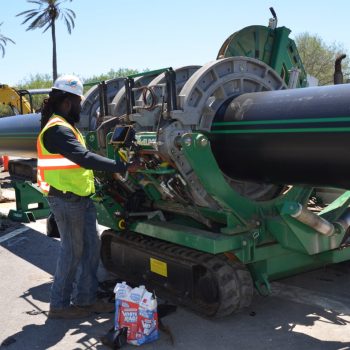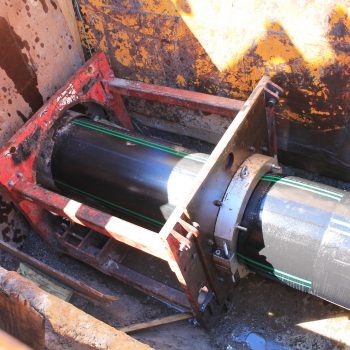A pilot project using the technology of CompressionFit HDPE pipe lining (Swagelining) and high-density polyethylene (HDPE) pipe was recently completed as part of an ongoing effort by the wastewater utility in Jacksonville, Fla., JEA, to rehabilitate its sewer force mains.
Jacksonville is hailed as the largest city in the US by area and JEA has approximately 3,800 miles in collection lines. Its unique and extensive service area spans parts of four counties. To accomplish its mission of providing high-quality utility services to more than 253,000 wastewater customers, the JEA sub-contracted with Murphy Pipelines Contractors, a trenchless utility company in Jacksonville, to replace a critical segment of 24-inch ductile iron sewer force main, which was part of a larger, overall project.
CompressionFit, also known in the past as Swagelining, is a pipe lining method in which the installed HDPE pipe is a compression fit carrier pipe within the host pipe. The method specifies an HDPE pipe with an outside diameter larger in size than the Internal Diameter (ID) of the host pipe to be renewed. After the HDPE is butt fused to correspond to the pull distance, the pipe is pulled through a reduction die immediately before entering the host pipe. This reduces the HDPE pipe temporarily below the ID of the host pipe allowing it to be inserted. While the towing load keeps the HDPE under tension during the pull, the pipe remains in its reduced size. The HDPE remains fully elastic throughout the reduction and installation process. After installation, the pulling load is removed. The HDPE pipe naturally expands until it is halted by the inside diameter of the host pipe resulting in a tight compressive fit. The tight fit maximizes the final ID compared to sliplining with a smaller size pipe.
Sliplining is one of the earliest methods utilized under the banner of trenchless technology which dates back to a commercial use from the 1940s. Although some historians believe sliplining was utilized by ancient civilizations. When flow and capacity can be reduced, sliplining may be a preferred method. However, when clients have the need to maximize the final ID, installing an HDPE pipe that results in a compression fit within the host pipe can add critical value to the pipeline system. Having a larger ID may assist to reduce pipeline pressures, eliminating pressure reducing valves or adding additional pump stations. In the case of the 24-inch JEA force main, flow calculations performed by JEA’s consulting engineering firm, Mott MacDonald, during the design phase showed the model of maximizing the final ID would add crucial value to the system.
The critical 2,200-foot force main identified by JEA to be evaluated by Mott MacDonald for the pilot study application of swagelining, was situated in a busy Florida DOT highway with limited space for conventional cut and cover construction, and numerous underground utilities. The high density urban environment along the highway included multiple retail and commercial businesses, hotels, bus stations, and gas stations.
ISCO provided a self-propelled TracStar® 900 machine, by McElroy, with powerful hydraulic clamping for efficient fusion of the pipe ends. The JEA’s HDPE pipe fusion data logging requirements were met with McElroy’s latest data logging tool — the DataLogger® 6 — which has been redesigned as a ruggedized tablet with an improved user interface.
“I loved it because it’s easy access,” said Ronttie Drayton of the new DataLogger® 6, a fusion operator for Murphy Pipelines. “All the features are there. It’s easier using the big screen and easier to take pictures.”
Joint reports from the DataLogger 6 were uploaded to the DataLogger Vault™, a secure internet server, where they could be checked to see that fusion operators fused at the right pressure and temperature for the right amount of time, according to ASTM standards. These quality assurance tools work together to ensure that joints are fused properly for a leak-free system, before pipe is even put in the ground.
Once the amount of fused pipe equaled the pull distance, it was pulled through a reduction die. This temporarily reduced the size of the 24-inch DIPS HDPE pipe so that it could enter the existing 24-inch ductile iron force main. After the HDPE pipe was pulled through the entire line and the towing load released, the unique flexibility of HDPE pipe allowed it to revert to form a compression fit within the host pipe.
By using Murphy Pipelines patented process for CompressionFit, 92% less excavation was needed which reduced public and environmental disruption. The cost to remove and replace new sidewalks and driveways and the impact on the pedestrian and motoring public along the FDOT roadway was also mitigated by utilizing the CompressionFit process.
Murphy Pipeline’s 6-man crew was able to fuse and pull a 2,200-foot pipeline within a single pull in 3 days. The HDPE pipe increased the force main’s flow rates with its smooth interior wall with a C-factor of 150 and its corrosion- and leak-free qualities will result in a pipeline that will serve residents for at least 100 years.


